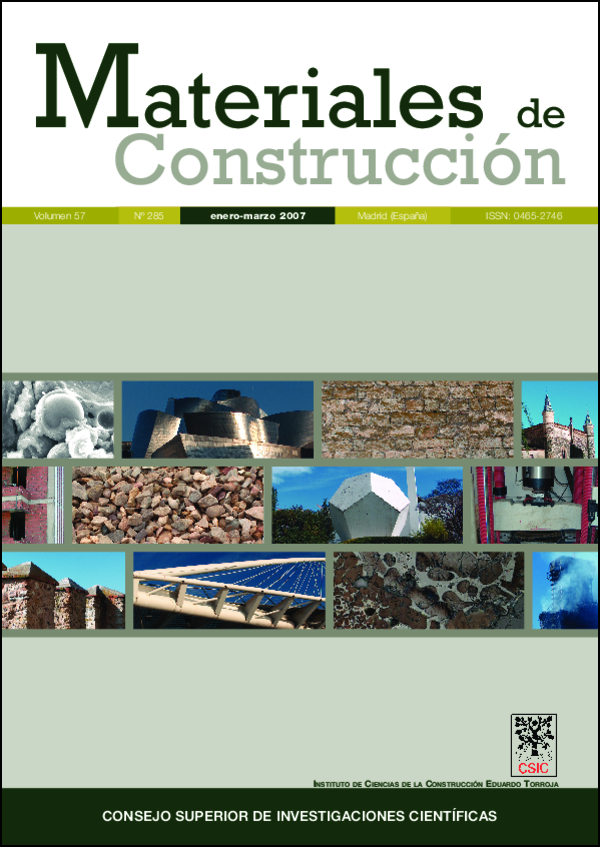The effects of steel fibre reinforced concrete on system ductility
DOI:
https://doi.org/10.3989/mc.2007.v57.i285.40Keywords:
composite, concrete, deformation, compressive strength, fibre-reinforcedAbstract
Steel fibre-reinforced concrete is being used extensively today in both field applications and experimental studies on concrete strength and ductility. The state of passive confinement generated by the fibre delays cracking and enhances ductility. The present paper reports on both experimental and analytical studies. In the former, a series of 16 steel-fibre reinforced concrete prismatic specimens were subjected to axial loads and the respective axial load-unit strain diagrams were subsequently plotted to determine the effect of steel fibres on reinforced concrete column ductility. Secondly, an analytical study was run to determine the additional ductility accruing to a frame system when steel fibres are included in the concrete. Analytical models were generated for 16 two-storey, single-span reinforced concrete frames. The columns in these frames were designed to the same characteristics as the specimens used in the experimental tests. Non-linear static (pushover) analyses were performed for each frame to obtain load-displacement curves and determine the effect of steel fibres on reinforced concrete column ductility.
Downloads
References
(1) Sukontasukkul P.; Mindess S.; Banthi N.: “Properties of confined fibre-reinforced concrete under uniaxial compressive impact”, Cement & Concrete Research, 35 (1) (2005), pp. 11-18. doi:10.1016/j.cemconres.2004.05.011
(2) Oh, B. H.; Park, D. G.; Kim, J. C.; Choi Y. C.: “Experimental and theoretical investigation on the post-cracking inelastic behavior of synthetic fiber reinforced concrete beams”, Cement & Concrete Research, 35 (2) (2005), pp. 384-392. doi:10.1016/j.cemconres.2004.07.019
(3) Song, P. S.; Hwang, S.: “Mechanical properties of high-strength steel reinforced concrete”, Construction and Building Materials, 18 (9) (2004), pp. 669-673. doi:10.1016/j.conbuildmat.2004.04.027
(4) Rao G.; Seshu, R.: “Torsion of steel fiber reinforced concrete members”, Cement & Concrete Research, 33 (11) (2003), pp. 1783- 1788. doi:10.1016/S0008-8846(03)00174-1
(5) Ayers, S. R.; Van Erp, G. M.: “A code of practice for the structural design of fibre composites” PIC Structures and Buildings, 157 (2003), pp. 3-8. doi:10.1680/stbu.157.1.3.36408
(6) Ramesh, K.; Seshu, D. R.; Prabhakar, M.: “Constitutive behavior of confined fibre reinforced concrete under axial compression”, Cement & Concrete Composites, 25 (2003), pp. 343-350. doi:10.1016/S0958-9465(02)00051-3
(7) Craig, R. J.; Patel, C.: “Behavior of joints using reinforced fibrous concrete”, Fibre Reinforced Concrete International Symposium, American Concrete Institute, Detroit, 1989.
(8) Sheikh, A. S.: “A comparative study of confinement models”, ACI J. Mater., 79 (04) (1982), pp. 296-306.
(9) Shah, S. P.; Rangan, B. V.: “Effects of reinforcements on ductility of concrete”, Proceeding ASCE, 96 (576) (1970), pp. 1167-1184.
(10) Gioncu, V.: “Framed structures. Ductility and seismic response, General Report”, Journal of Constructional Steel Research, 55 (2000), pp. 125-154. doi:10.1016/S0143-974X(99)00081-4
(11) Kappos, A. J.; Chryssanthopoulos, M. K.; Dymiotis, C.: “Uncertainty analysis of strength and ductility of confined reinforced concrete members”, Engineering Structures, 21 (1999), pp. 195-208. doi:10.1016/S0141-0296(97)00181-8
(12) Lu, Y.; Hao, H.; Carydis, P. G.; Mouzakis, H.: “Seismic performance of RC frames designed for three different ductility levels”, Engineering Structures, 23 (2001), pp. 537-547. doi:10.1016/S0141-0296(00)00058-4
(13) Regulations on Structures constructed in Disaster Regions (TEC-98), Ministry Of Public Works and Settlement, Ankara, 1998.
(14) UBC-97 Uniform Building Code, International Conference of Buildings Official, USA, 1997.
(15) Eurocode-8-98 Design Provisions for Earthquake Resistance of Structures, European Union, European Prestandarts, Brussel, 1998.
(16) Borzi, B.; Elnashai, A. S.: “Refined Force Reduction Factor for Seismic Design”, Engineering Structures, 2000, pp. 1244-1260. doi:10.1016/S0141-0296(99)00075-9
(17) Kappos, A. J.: “Evaluation of Behaviour Factor on the Basis of Ductility and Overstrength Studies”, Engineering Structures, 1999, pp. 823-835. doi:10.1016/S0141-0296(98)00050-9
(18) TBC-500-2000, Turkish Building Code, Requirements For Design and Construction of Reinforced Concrete Structures, 2000.
(19) Richart, F. E.; Staehle, G. C.: “Column Tests at University of Illinois”, Journal of ACI, febrero-marzo de 1931, noviembre de 1931 y enero de 1932.
(20) Slater, W. A.; Lyse, I.: “Column Tests at Lehigh University”, Journal of ACI, marzo de 1931, noviembre de 1931 y enero de 1932.
(21) Prakash, V.; Powell, G. H.; Campbell, S.: Drain-2dx User Guide V.1.10, Departmant of Civil Engineering, University of California at Berkeley, 1993.
(22) Mwafy, A. M.; Elnashai, A. S.: “Calibration of Force Reduction Factors of RC Buildings”, Journal of Earthquake Engineering, vol. 6, nº 2 (2002), pp. 239-273. doi:10.1142/S1363246902000723
(23) Mwafy, A. M.; Elnashai, A. S.: “Static Pushover Versus Dynamic Collapse Analysis of RC Buildings”, Engineering Structures, 2001, pp. 407-424. doi:10.1016/S0141-0296(00)00068-7
(24) Paulay, T.; Priestly, M. J. N.: “Seismic Design of Reinforced Concrete and Masonry Buildings”, Concrete & Cement Composites, John Wiley & Sons Interscience Publication, Nueva York, 1992.
Downloads
Published
How to Cite
Issue
Section
License
Copyright (c) 2007 Consejo Superior de Investigaciones Científicas (CSIC)

This work is licensed under a Creative Commons Attribution 4.0 International License.
© CSIC. Manuscripts published in both the print and online versions of this journal are the property of the Consejo Superior de Investigaciones Científicas, and quoting this source is a requirement for any partial or full reproduction.
All contents of this electronic edition, except where otherwise noted, are distributed under a Creative Commons Attribution 4.0 International (CC BY 4.0) licence. You may read the basic information and the legal text of the licence. The indication of the CC BY 4.0 licence must be expressly stated in this way when necessary.
Self-archiving in repositories, personal webpages or similar, of any version other than the final version of the work produced by the publisher, is not allowed.
















